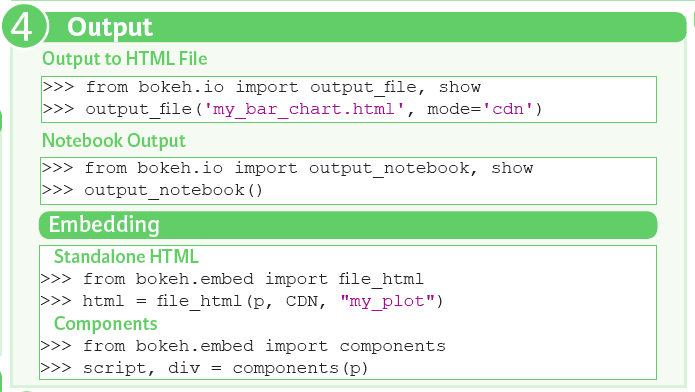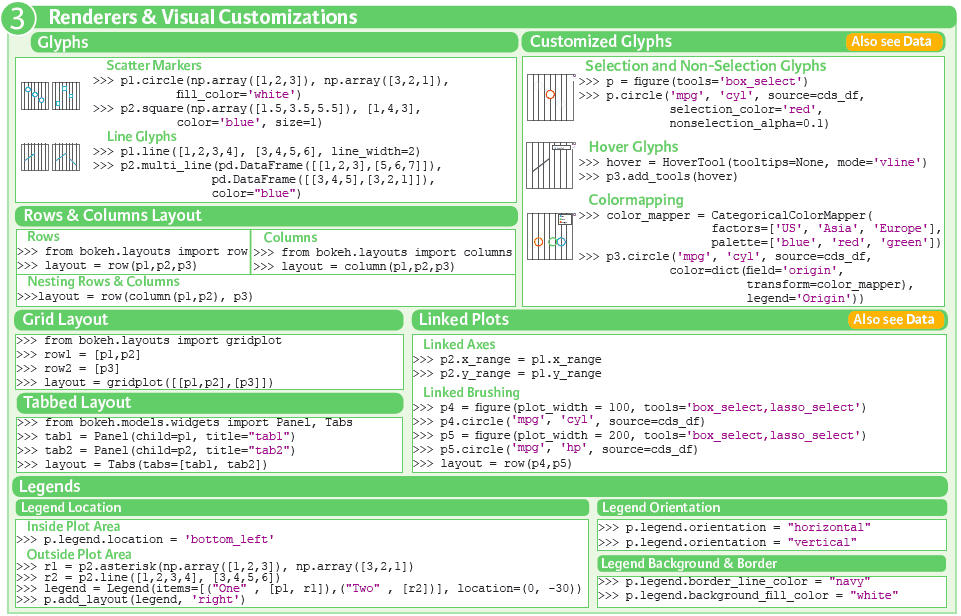What did I want out of this photo? But this time, bumping the aperture all the way down to 2.8 (as low as this lens will go) was too much bokeh. Try bumping up your aperture to 3.2, 4.0 or even 5.6 to see how it changes the look of your photo. Here’s a good example of the difference it can make: A Quick Comparison of Aperture.
- Python For Data Science Cheat Sheet Bokeh Learn Bokeh Interactively at www.DataCamp.com, taught by Bryan Van de Ven, core contributor Plotting With Bokeh.
- December 8, 2016 @tachyeonz #bokeh, cheatsheet, data analytics, data visualization, dataviz, iiot, python @tachyeonz: Bokeh distinguishes itself from other Python visualization libraries such as Matplotlib or Seaborn in the fact that it is an interactive visualization library that is ideal for anyone who would like to quickly and easily create.
At DataCamp, we always look out for ways to help our students, who are all eager to become more data savvy, reach their objectives even faster. That’s why we recently created a series of Python cheat sheets that target people who are using it for data analysis. The ongoing series already covers some of the most important and fundamental topics in data science and are must-haves for anyone that wants to get started with Python for data science.
At DataCamp, we always look out for ways to help our students, who are all eager to become more data savvy, reach their objectives even faster. That’s why we recently created a series of Python cheat sheets that target people who are using it for data analysis. The ongoing series already covers some of the most important and fundamental topics in data science and are must-haves for anyone that wants to get started with Python for data science.
And if you haven’t yet, you should consider learning this programming language. Year after year, Python’s popularity is increasing in the data science industry. The use of Python as a data science tool has been on the rise over the past few years: 54% of the respondents of the latest O'Reilly Data Science Salary Survey indicated that they used Python. The results of the 2015 survey showed that 51% of the respondents used Python.
Nobody can deny that Python has been on the rise in the data science industry and it certainly seems that it's here to stay.
So why not start now and make sure that the first steps you take count?
Get a copy of Python for data science cheat sheet and go through DataCamp’s Intro to Python for Data Science course. You’ll cover topics such as variables and data types, strings, lists, the basics of NumPy arrays, and much more. Complete your Python basics with an interactive Python List tutorial, to practice using this built-in data structure in Python for data analysis.
After, it’s time to lay the foundation for learning other data science libraries and dig deeper into (part of) the fundaments of the Pandas and Scikit-Learn libraries: take a look at NumPy, the Python scientific computing library that is excellent for data analysis. You’ll see that this library provides you with an array data structure that is a great alternative to Python lists: it is more compact, allows faster access when you’re reading and writing items, and is more convenient and more efficient overall.
The NumPy cheat sheet will introduce you to array creation, array mathematics, selecting elements (through subsetting, slicing and indexing), array manipulation and much more!
Make sure to use the reference sheet when you’re practicing arrays with DataCamp’s Python NumPy Tutorial or when you go through the Intro to Python for Data Science course. Undoubtedly, you’ll take your first steps with NumPy with confidence!
When you have mastered the basics, it’s time to get your hands dirty and analyze some real-life data. But you cannot start without the Pandas library: it’s all you ever need and want to use if you want to do data manipulation and analysis in Python.
But don’t go in unprepared: take DataCamp’s Pandas Foundations and Manipulating DataFrames with Pandas courses and make sure to keep the Pandas cheat sheet handy when you’re starting the Pandas DataFrame tutorial, where you can get extra practice to use this fast, flexible and expressive data structure.
Just like the tutorial, the cheat sheet not only gives basic information about the Pandas data structures and how to select values or basic statistics from them, but also shows you how inputting and outputting of data, sorting and ranking the data in your DataFrame or Series and data alignment works.
After you have already explored your data with some summary statistics on your DataFrame and manipulated your data in such a way that it’s ready for further analysis, it’s time to visualize your data!
Bokeh Cheat Sheet Roblox
The Bokeh library is the one that you need quickly and easily create interactive plots, dashboards, and data applications. What’s more, Bokeh enables high-performance visual presentations of large data sets in modern web browsers!
This Python visualization library is a powerful tool for your data science toolbox, so why not get started straight away?
First, get a copy of our Bokeh cheat sheet: it will make you familiar with the steps you need to go through to plotting and creating statistical charts. It summarizes how you can prepare your data, create a new plot, add renderers for your data with custom visualizations, output your plot and save or show it. Also, the creation of basic statistical charts will hold no secrets for you any longer.
But don’t just sit around and look at the cheat sheet: take the Interactive Data Visualization with Bokeh course and get the practice you need to become a data viz wizard in no time!
After exploring your data, you’ll have even more detailed research questions. Here’s where modeling your data gets important if you want to find a solid answer for them.

Machine learning is essential to data science; And everybody that says “machine learning” and “Python” in the same sentence, knows that Scikit-Learn is the way to go for machine learning in Python. This library implements a wide variety of machine learning, preprocessing, cross-validation and visualization algorithms with the help of a unified interface.


However, starting to tackle machine learning problems can be a pain: you don’t necessarily know where to start and how to go about it. That’s why the Scikit-Learn cheat sheet is a perfect companion to your first steps with Scikit-Learn: you'll not only see how to load in your data and how to preprocess it, but you’ll also see how to create your own model to which you can fit your data and predict target labels. Validation and tuning of your models to improve performance are also included in the reference sheet. Keep it handy while you’re going through our Scikit-Learn tutorial with character recognition as a topic.
About DataCamp
DataCamp is an online interactive education platform that focuses on building the best learning experience specifically for Data Science.
Anaconda Perspectives
Data Scientists: Bring the Narrative to the ForefrontRead MoreAnaconda Perspectives
There Is No Data – Only Frozen ModelsBokeh Cheat Sheet
Read MoreAnaconda Perspectives
Why Organizations Should Invest in a Chief Data OfficerBokeh Cheat Sheet Download
